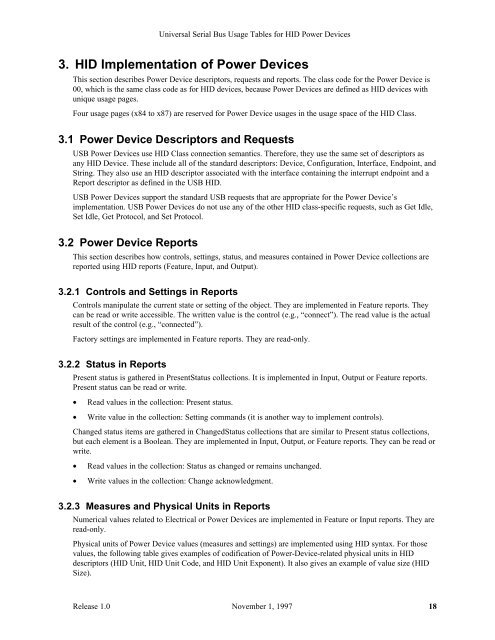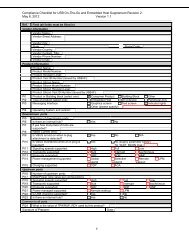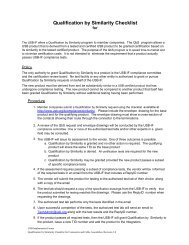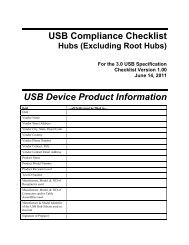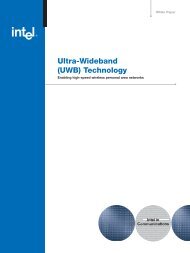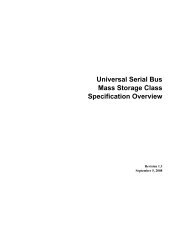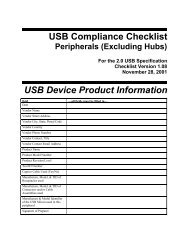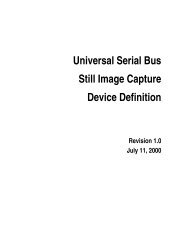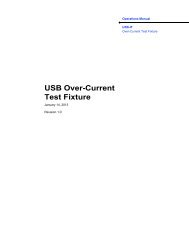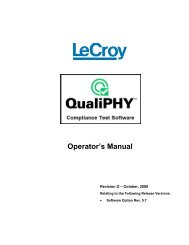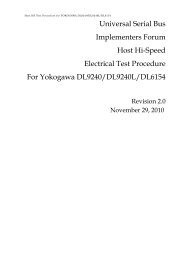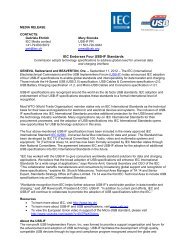Universal Serial Bus Usage Tables for HID Power Devices - USB.org
Universal Serial Bus Usage Tables for HID Power Devices - USB.org
Universal Serial Bus Usage Tables for HID Power Devices - USB.org
You also want an ePaper? Increase the reach of your titles
YUMPU automatically turns print PDFs into web optimized ePapers that Google loves.
<strong>Universal</strong> <strong>Serial</strong> <strong>Bus</strong> <strong>Usage</strong> <strong>Tables</strong> <strong>for</strong> <strong>HID</strong> <strong>Power</strong> <strong>Devices</strong><br />
3. <strong>HID</strong> Implementation of <strong>Power</strong> <strong>Devices</strong><br />
This section describes <strong>Power</strong> Device descriptors, requests and reports. The class code <strong>for</strong> the <strong>Power</strong> Device is<br />
00, which is the same class code as <strong>for</strong> <strong>HID</strong> devices, because <strong>Power</strong> <strong>Devices</strong> are defined as <strong>HID</strong> devices with<br />
unique usage pages.<br />
Four usage pages (x84 to x87) are reserved <strong>for</strong> <strong>Power</strong> Device usages in the usage space of the <strong>HID</strong> Class.<br />
3.1 <strong>Power</strong> Device Descriptors and Requests<br />
<strong>USB</strong> <strong>Power</strong> <strong>Devices</strong> use <strong>HID</strong> Class connection semantics. There<strong>for</strong>e, they use the same set of descriptors as<br />
any <strong>HID</strong> Device. These include all of the standard descriptors: Device, Configuration, Interface, Endpoint, and<br />
String. They also use an <strong>HID</strong> descriptor associated with the interface containing the interrupt endpoint and a<br />
Report descriptor as defined in the <strong>USB</strong> <strong>HID</strong>.<br />
<strong>USB</strong> <strong>Power</strong> <strong>Devices</strong> support the standard <strong>USB</strong> requests that are appropriate <strong>for</strong> the <strong>Power</strong> Device’s<br />
implementation. <strong>USB</strong> <strong>Power</strong> <strong>Devices</strong> do not use any of the other <strong>HID</strong> class-specific requests, such as Get Idle,<br />
Set Idle, Get Protocol, and Set Protocol.<br />
3.2 <strong>Power</strong> Device Reports<br />
This section describes how controls, settings, status, and measures contained in <strong>Power</strong> Device collections are<br />
reported using <strong>HID</strong> reports (Feature, Input, and Output).<br />
3.2.1 Controls and Settings in Reports<br />
Controls manipulate the current state or setting of the object. They are implemented in Feature reports. They<br />
can be read or write accessible. The written value is the control (e.g., “connect”). The read value is the actual<br />
result of the control (e.g., “connected”).<br />
Factory settings are implemented in Feature reports. They are read-only.<br />
3.2.2 Status in Reports<br />
Present status is gathered in PresentStatus collections. It is implemented in Input, Output or Feature reports.<br />
Present status can be read or write.<br />
• Read values in the collection: Present status.<br />
• Write value in the collection: Setting commands (it is another way to implement controls).<br />
Changed status items are gathered in ChangedStatus collections that are similar to Present status collections,<br />
but each element is a Boolean. They are implemented in Input, Output, or Feature reports. They can be read or<br />
write.<br />
• Read values in the collection: Status as changed or remains unchanged.<br />
• Write values in the collection: Change acknowledgment.<br />
3.2.3 Measures and Physical Units in Reports<br />
Numerical values related to Electrical or <strong>Power</strong> <strong>Devices</strong> are implemented in Feature or Input reports. They are<br />
read-only.<br />
Physical units of <strong>Power</strong> Device values (measures and settings) are implemented using <strong>HID</strong> syntax. For those<br />
values, the following table gives examples of codification of <strong>Power</strong>-Device-related physical units in <strong>HID</strong><br />
descriptors (<strong>HID</strong> Unit, <strong>HID</strong> Unit Code, and <strong>HID</strong> Unit Exponent). It also gives an example of value size (<strong>HID</strong><br />
Size).<br />
Release 1.0 November 1, 1997 18


